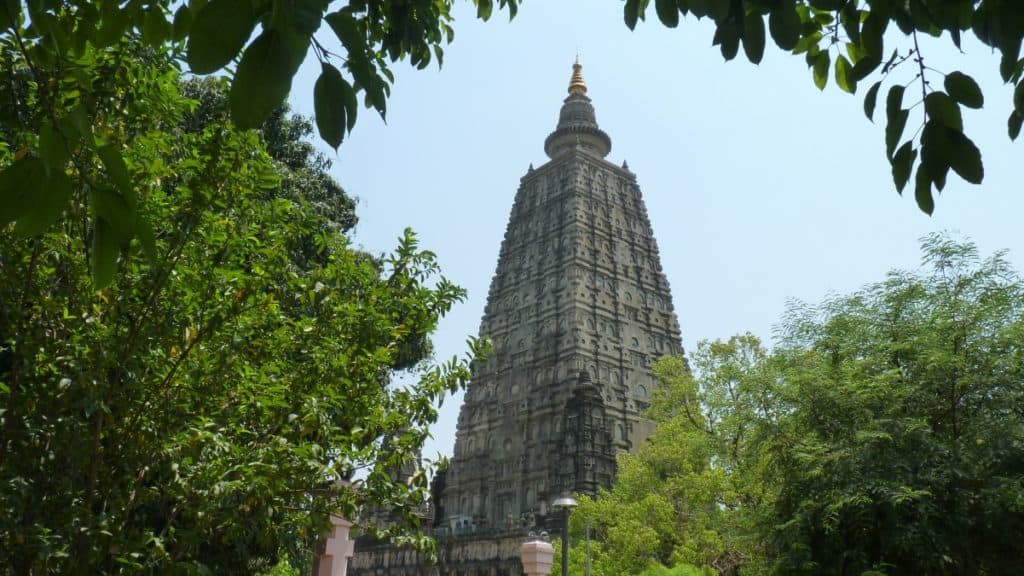Last Updated on March 2, 2025 by Ellen
We went to Bodhgaya to see where the original Buddha became enlightened. The Mahabodhi Temple Complex features a descendant of the tree where the Buddha meditated and reached enlightenment. The 2,500-year-old spot is the most holy of four pilgrimage sites for Buddhists, and it is a UNESCO World Heritage Site.
But the entire region has ‘Buddha’s footprints’ and there are plenty of historic sites to see in the region – including the world’s first university, where the ruins and the stories blew me away.
Bodhgaya
Mahabodhi Temple Complex
The bodi tree is the ‘tree of awakening.’ It’s a fig tree that’s sacred to Buddhists.
The story goes an emperor’s daughter took a branch from the original tree in Bodhgaya to Sri Lanka and planted it. The bodi tree at the Mahabodhi Temple Complex today is from a sapling of the tree in Sri Lanka.
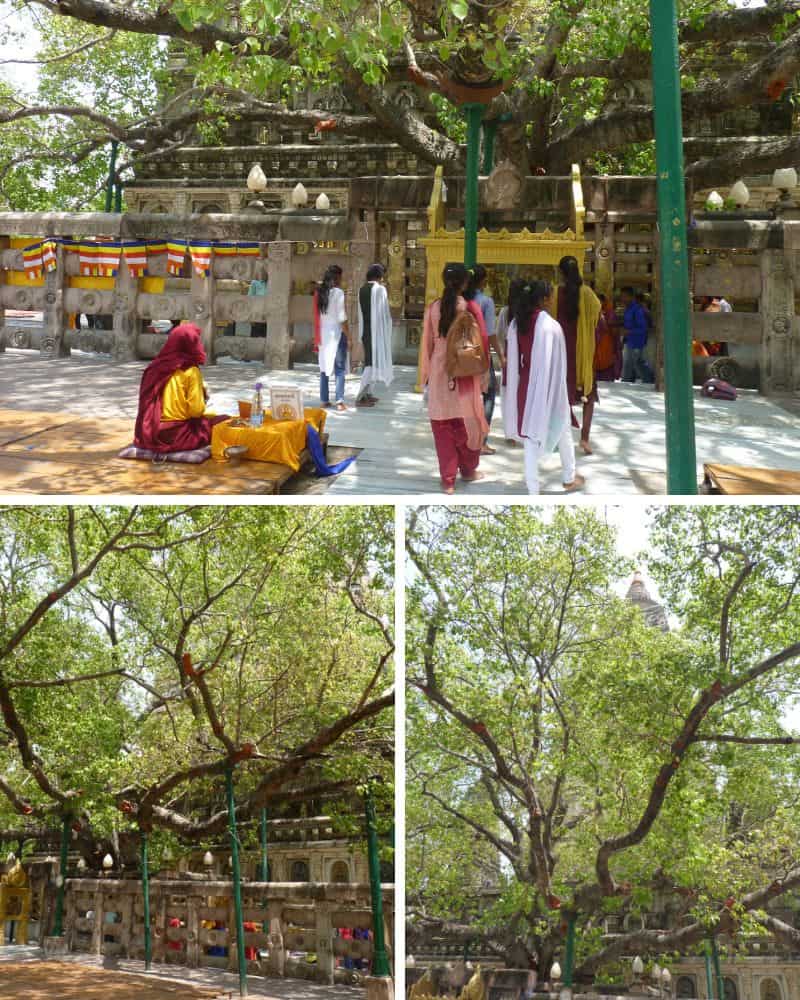
The original shrine was built right in front of the tree. It dates back to 300 BC.
Amazingly, some stone railings around the original complex survived. Older sandstone posts date back about 150 BC, decorated with animals, amorous couples, lotus flower and wheel designs. Other granite railings from the 7th century also survived.
The railings are inside the Bodhgaya Archeological Museum.
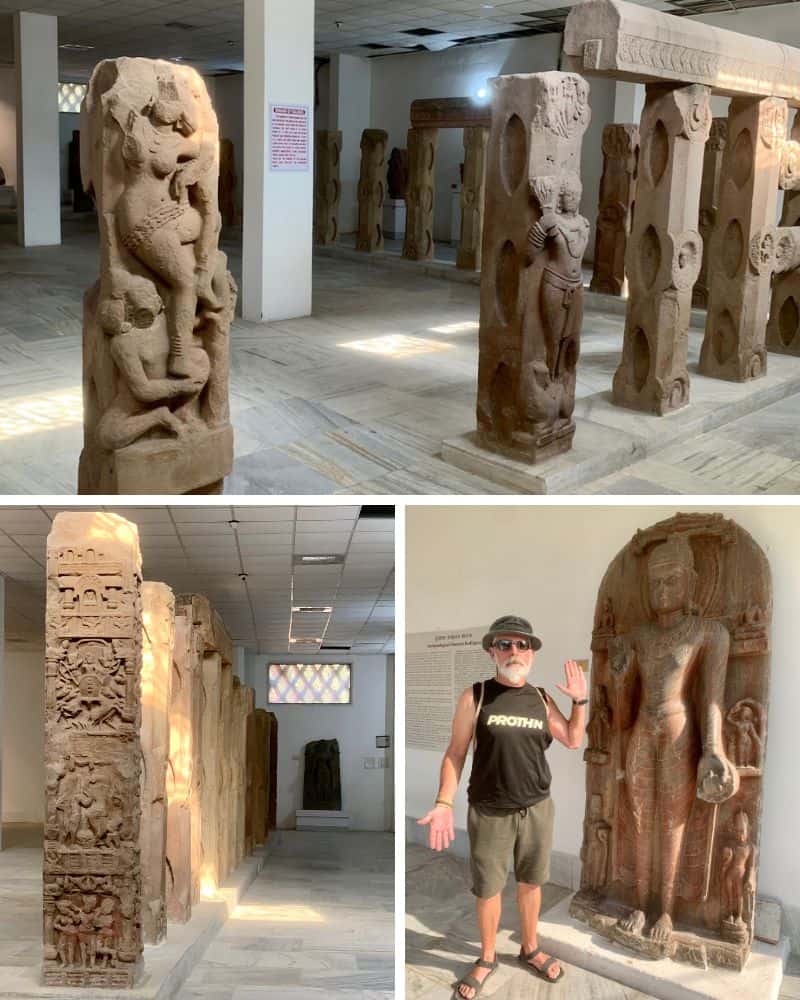
The current temple dates back to the 6th century, although it has been rebuilt and repaired. It features a golden stupa top inlaid with 300 kilos of gold, gifted by devotees from Thailand in 2013.
In a stroke of synchronicity, the golden top was cleaned the week leading up to the world shutting down for the coronavirus pandemic. The last cleaning day was the day Theo, his mother Diane, and I were locked down in Malay, Aklan, Philippines.
The temple also features Buddha statues around the base of the tree and inside the temple.
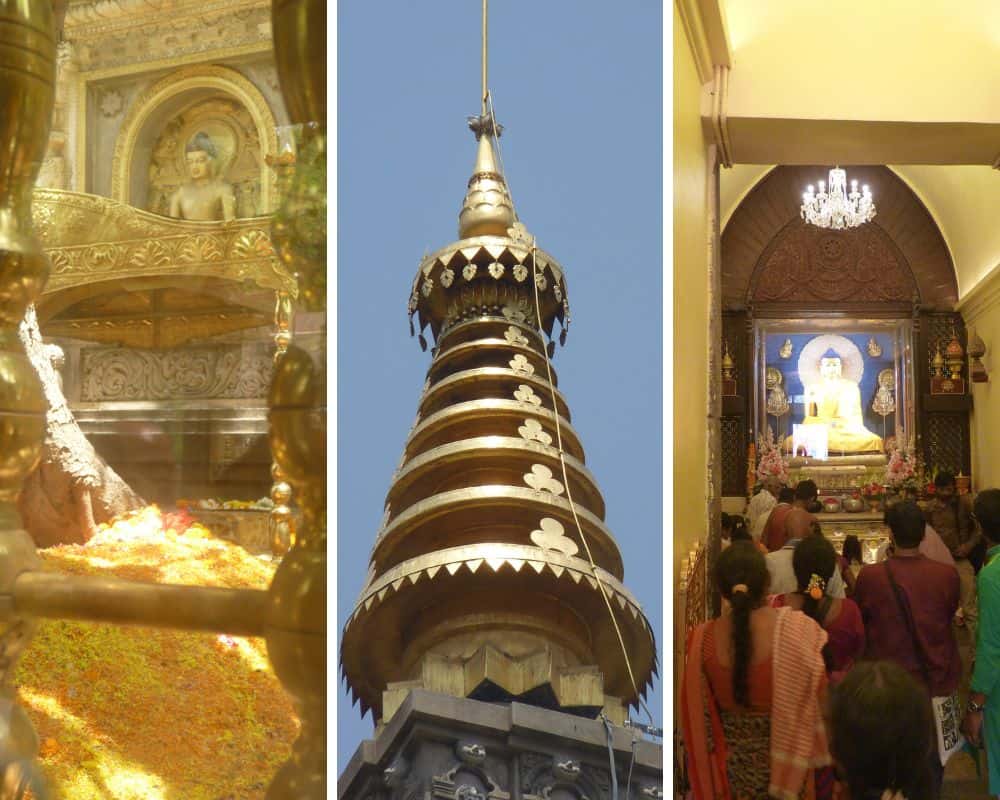
The Mahabodhi Temple Complex grounds are gorgeous. There are more statues, gardens and Buddhist history carved into stone on the walls.
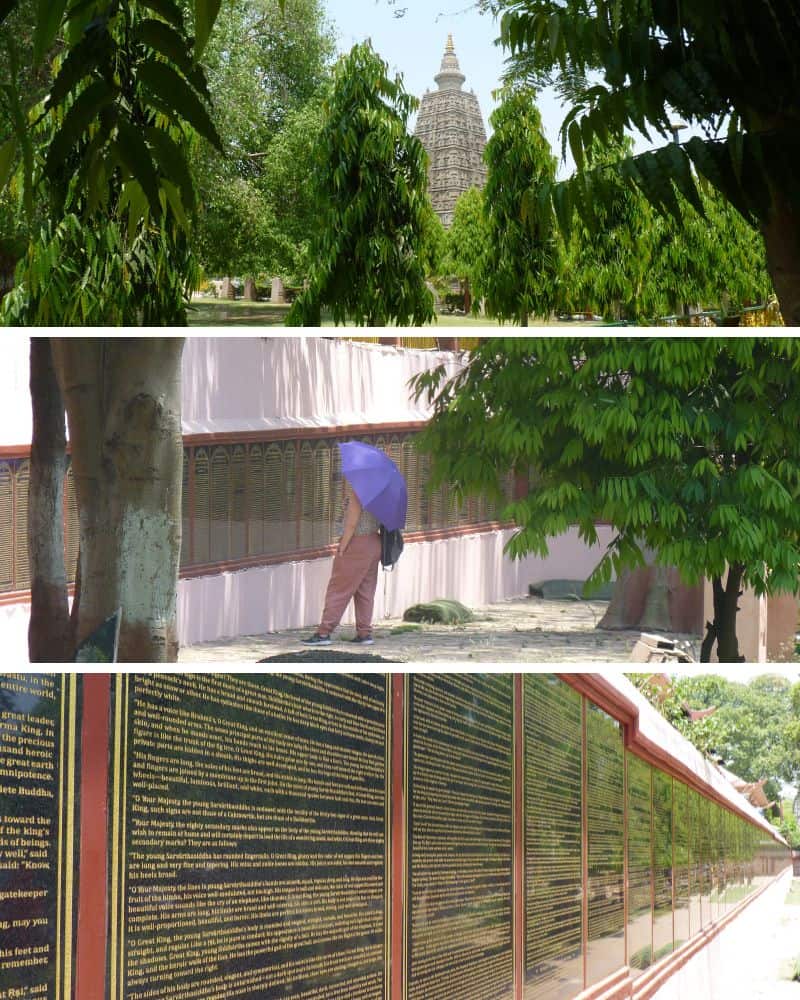
There is a special mediation garden with a World Peace bell from Hue, Vietnam, a gift from the late Thich Nhat Hahn.
Related: Hue, Vietnam: historic yet new
Mom Diane, still traveling with us, said the Mahabodhi Complex is “the nicest place in town.” Unbothered by the temperatures nearing 110 degrees, she spent many hours there.
Bodhgaya temples & beggars
Indeed, the Mahabodhi Temple Complex is a relatively quiet oasis from the hot, dusty town where beggars line the entrances to dozens of smaller temples. There other Buddhist temples represent Japan, Myanmar, Thailand, Cambodia, and other countries.
The begging is intense at these other temples. Begging is ‘not allowed’ inside the Mahabodhi Temple Complex, but we had several beggars approach us there, as well.
A local resident told us people from all over India come to Bodhgaya just to beg. Their reasoning is that well-to-do Buddhist tourists will help them because of their belief that all beings matter.
Beggars are all over India. But in Bodhgaya, it’s tougher because these people are the poorest of the poor, and they are often severely handicapped.
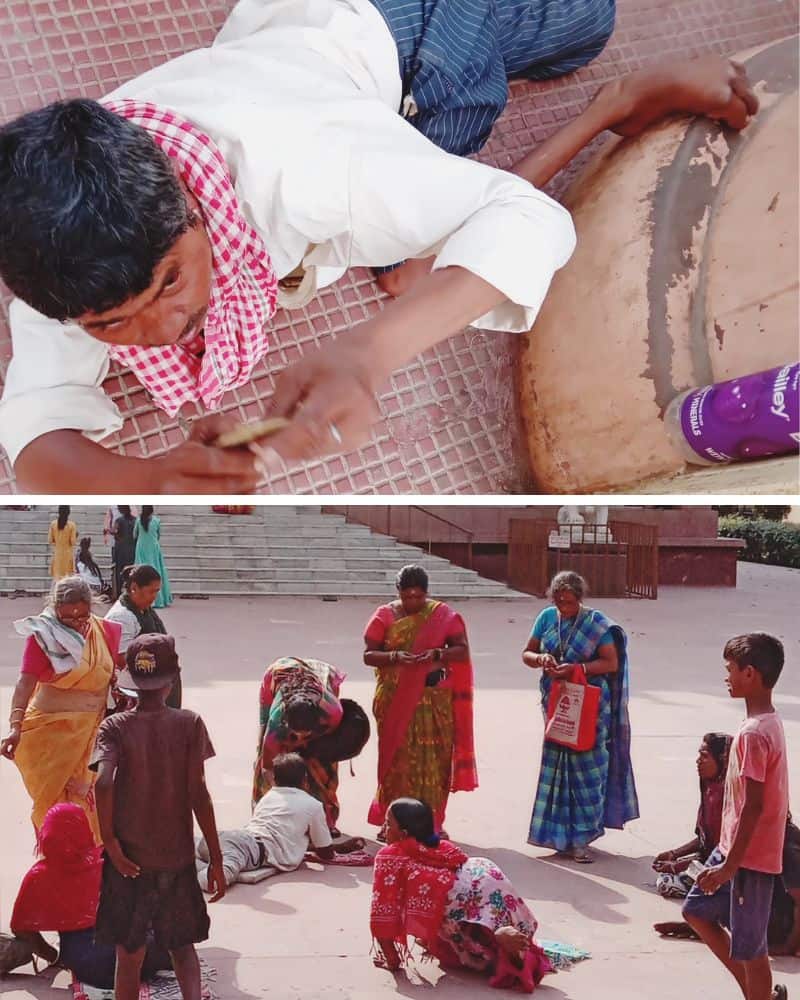
It’s heartbreaking to watch these beggars, and not be able to do more to help them. Story of our travel lives.
Security in the Mahabodhi Temple Complex is extremely tight — no cell phones are allowed. There are free lockers to check your phone. The reason is because of a bombing several years ago.
A monastery outside of the Mahabodhi Complex was also bombed, but there didn’t appear to be any security checks at the Tergar Monastery when we briefly visited. Young boys were chanting and playing instruments when we checked out the Tibetan-style monastery.
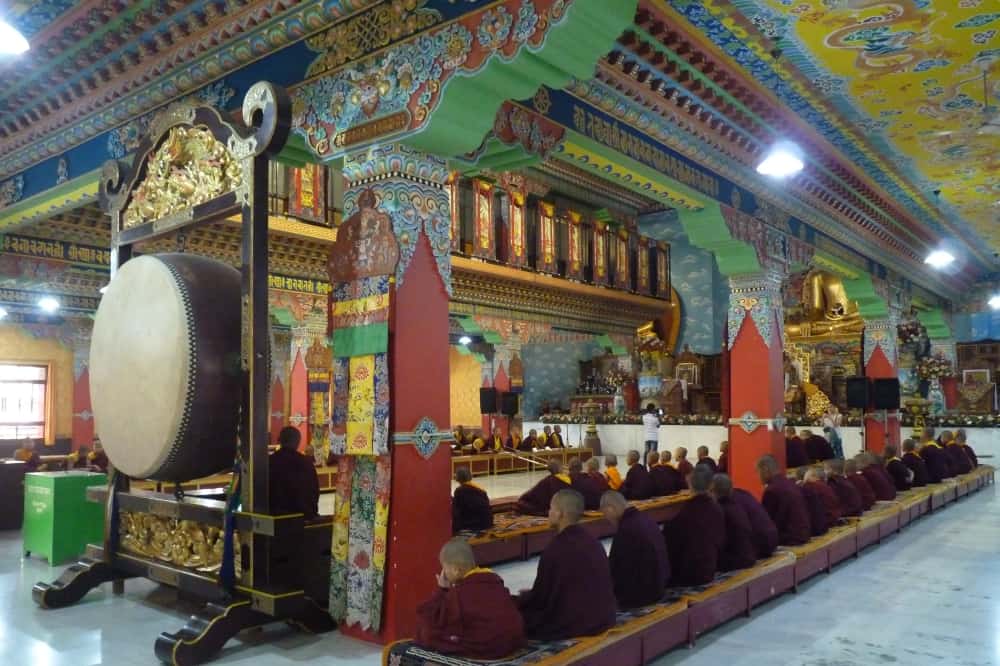
Bodhgaya Math
Down the riverfront road (now a dry river) from the Mahabodhi Temple Complex is the old Bodhgaya Math (Hindu monastery). For centuries, this Hindu-ruled site controlled the oversight of the Buddhist complex.
Today, it’s partly in ruins, and partly run down. There is a Hindu temple that is kept up nicely, and a few facades with carvings, but that’s about it.
Still, it’s interesting to wander around a little.
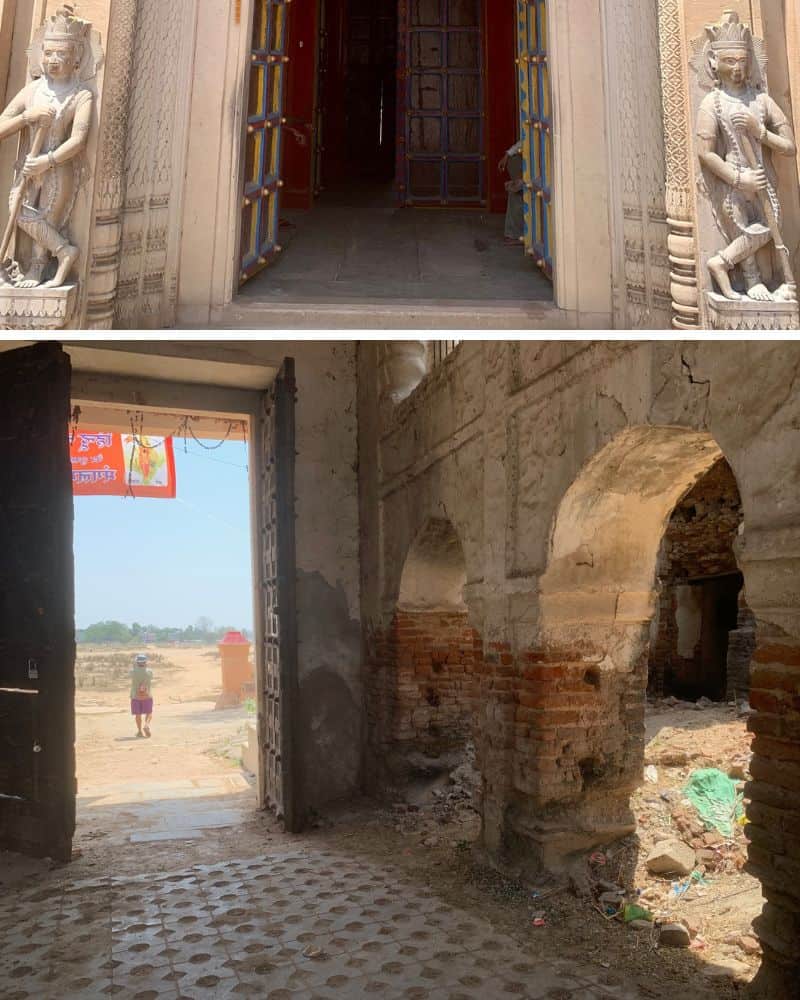
Finding easy historical information about the Bodhgaya Math in English online is not easy. Most of the references are from archaeological books.
This map can help you find it.
Mahakala Caves
Aside from the temples, monasteries, and a museum, there’s not much else to see in Bodhgaya proper. So we hired a tuktuk driver to take us the Mahakala Caves in Dungeshwari Hills. This is where the Buddha meditated for six years before enlightenment.
Beware of the beggars — it’s endless! On the way up the paved walkway to the main cave, children tried sell us long sticks to keep monkeys away. At one point, we bought some biscuits to hand out to children.
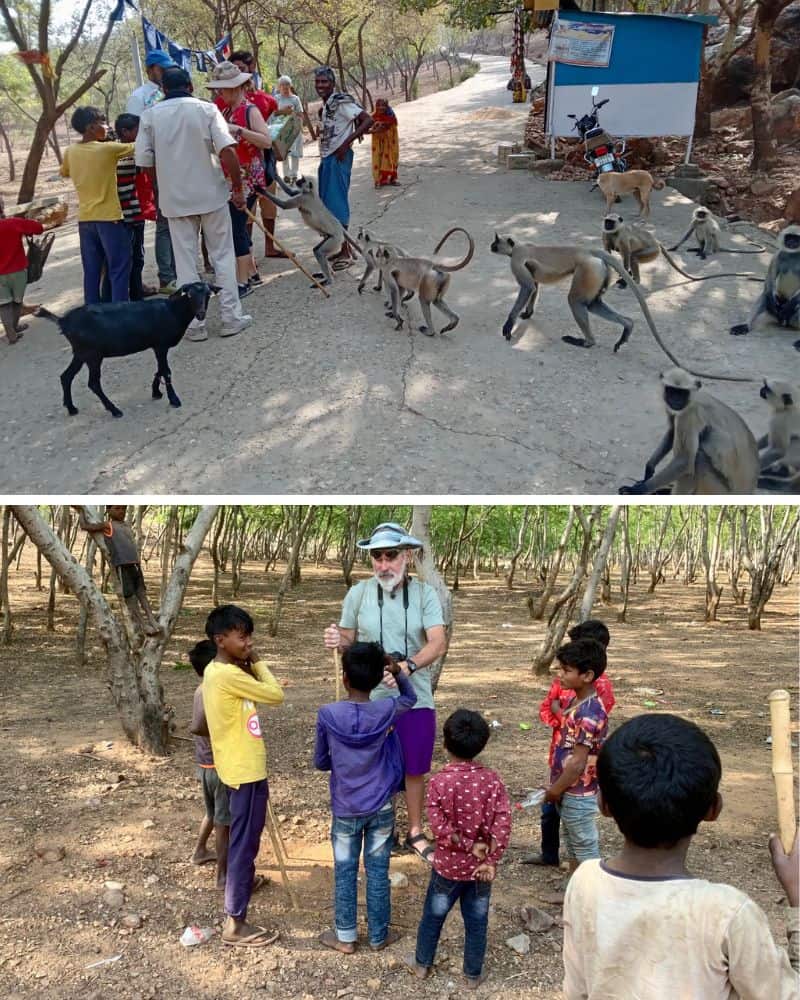
We ended up ‘hiring’ the boys after we visited the main cave to show us other caves on the grounds. We used Google Translate to communicate. They were so poor – they smelled like the homeless smell, and not all of them had shoes.
The cave where the Buddha meditated is small and hot. There is a statue of an emaciated Buddha because it was during this time that he fasted for years.
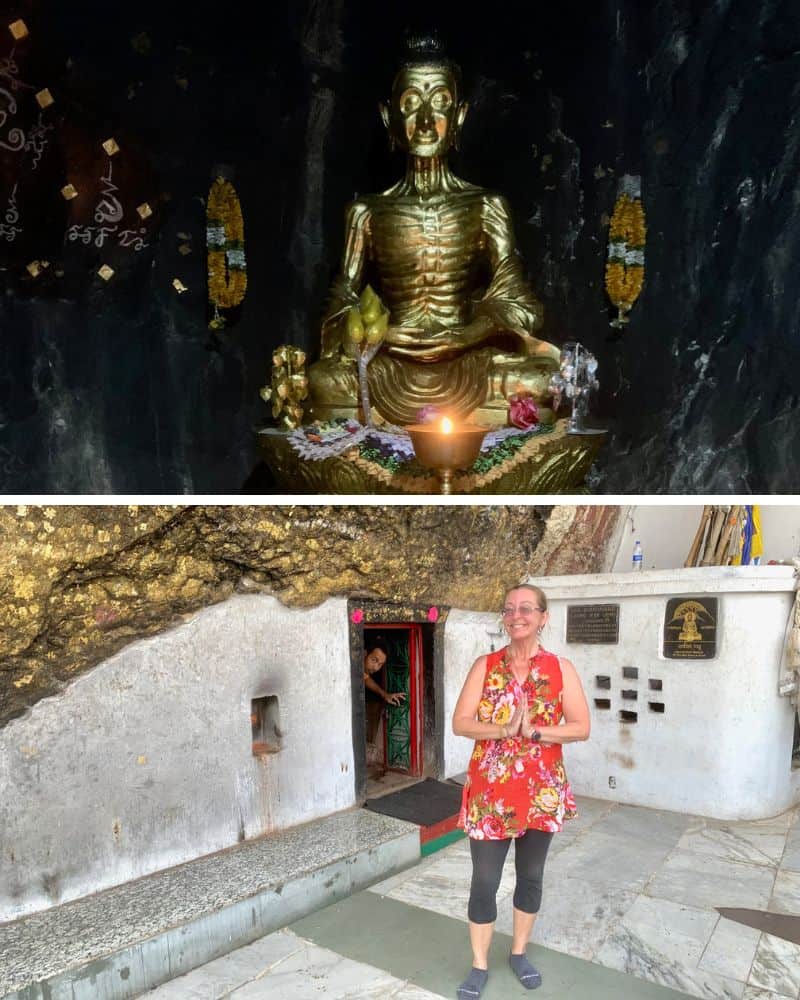
This is interesting to me because most Buddha statues don’t show his ribs.
Eventually, the Buddha realized extreme deprivation was not the path to enlightenment.
Sujata Stupa
We also saw the ruins of Sujata Stupa. It had been quarried for supplies a few centuries ago. But 21st century excavations revealed it was built to honor the woman who gave the Buddha rice and milk that broke his seven-year fast, which was a key step on his path to awakening by the ‘Middle Way’. That is, to avoid extremes such as extreme indulgence and deprivation.
Some antiquities unearthed during excavations are in the Bodhgaya Museum.
At this site, we were approached by a man asking for donations to a local school. Instead, Theo marched past him and gave a donation to the workers digging a trench for some unknown reason.
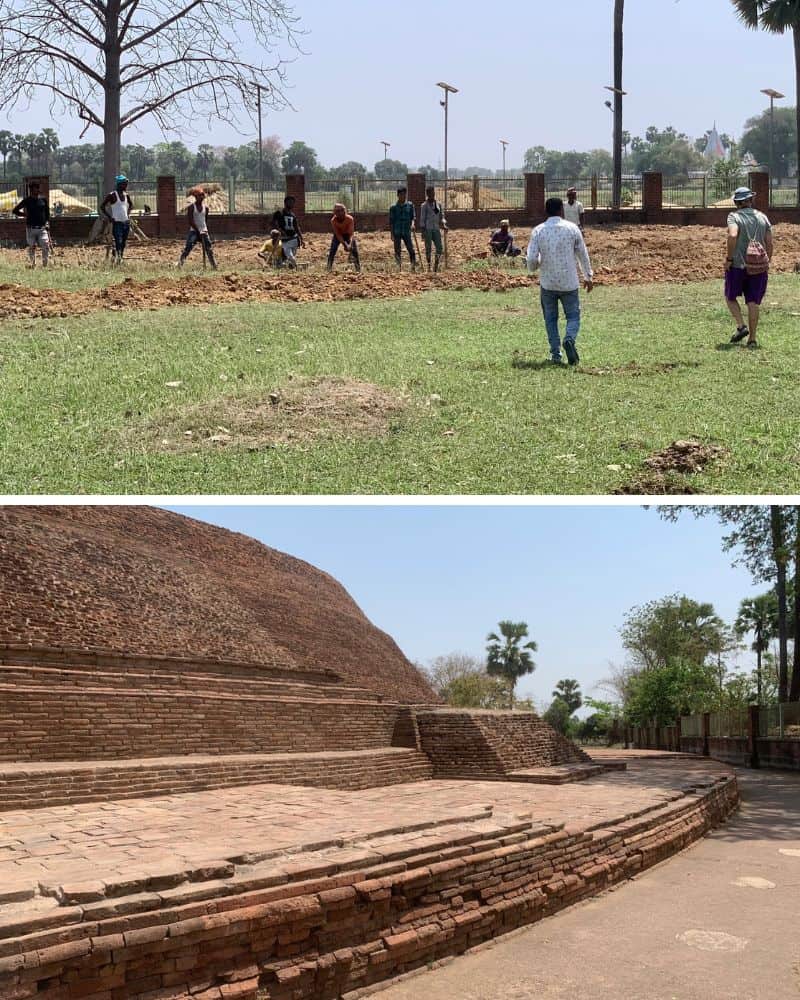
Afraid of health care overseas? Don’t be!
Our special guide on global health care shows you:
- 7 easy steps to find the right doctors and hospitals
- Specific price examples for various medical services
- What to know about medical visas
- And more!
We go without travel health insurance, but many of the principles apply to those with coverage.
The Buddhist Circuit
Another day, we hired a driver and his air conditioned car to take us on the ‘Buddhist Circuit’. It’s a collection of historic sites in the state of Bihar.
Vishwa Shanti Stupa
Theo hand-curated our route from a selection of sites on the Buddhist Circuit. Our first stop was at a rare, single seat, open-air cable car ride up to the Vishwa Shanti Stupa. It’s one of several Buddhist monuments around the world that encourage world peace.
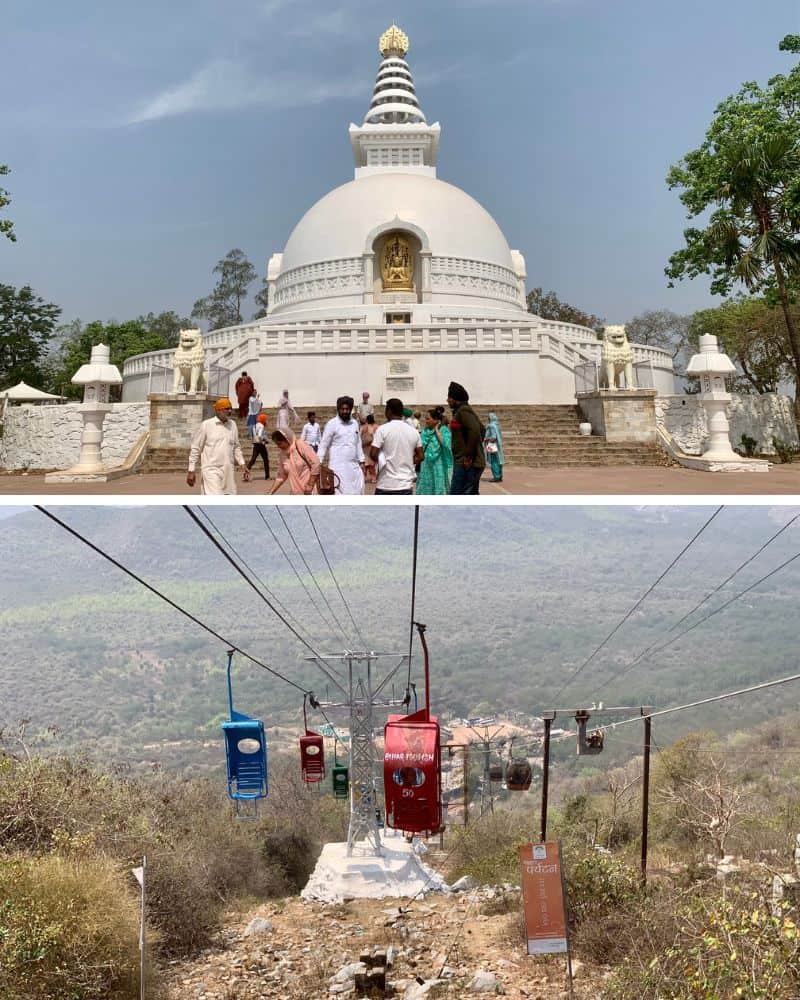
It was definitely a fun ride up! You can’t really see her in the shot above, but Mom Diane is in the car ahead mine.
The Japanese monk behind several famous Shanti Stupas is honored at this site. We saw another of his projects in Pokhara, Nepal.
Also, the famed Vulture Peak is near this site. That’s where the Buddha is said to have taught students.
Former gold treasury and other sites
We stopped a few more times, to see old ‘chariot tracks’ and a former gold treasury of an ancient Indian king. The treasury was also a meditation hall deep in the rock, which had much cooler air.
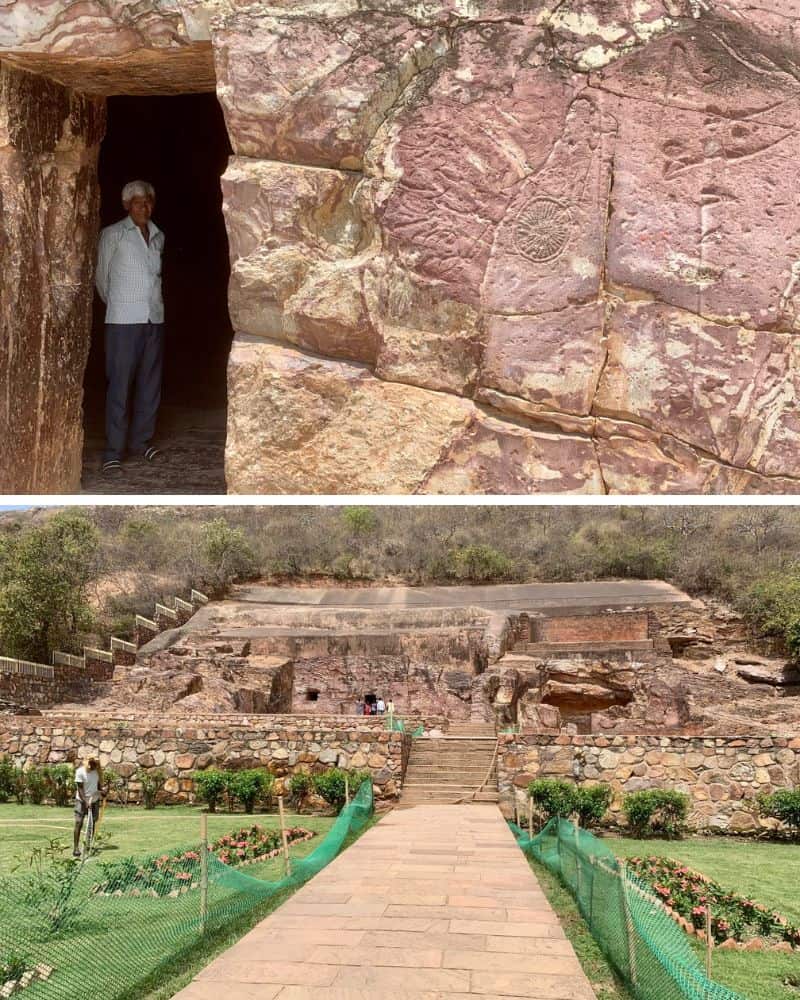
We were hounded by beggars at theses spots, just as in Bodhgaya. But there are also plenty of people trying to make a living. Vendors sell (sort of cool) drinks, and men offer horse and carriage rides around the sites.
These smaller sites are well maintained and many are free. We couldn’t stop at all of them – there wasn’t enough time before the day’s main attraction — Nalanda University.
Nalanda University
The highlight our Buddhist Circuit trip was the old Nalanda monastery and university, now in ruins. I had never even heard of it until a few days before we went to the site.
Nalanda is considered the world’s first residential university. It housed a staggering 9 million books and drew 10,000 students from eastern and central Asia. Nalanda changed the world — its name was news to me! As early as 427 CE, students went to Nalanda to learn Buddhism. At that time it was a monastery. In the years that followed, it eventually became a university.
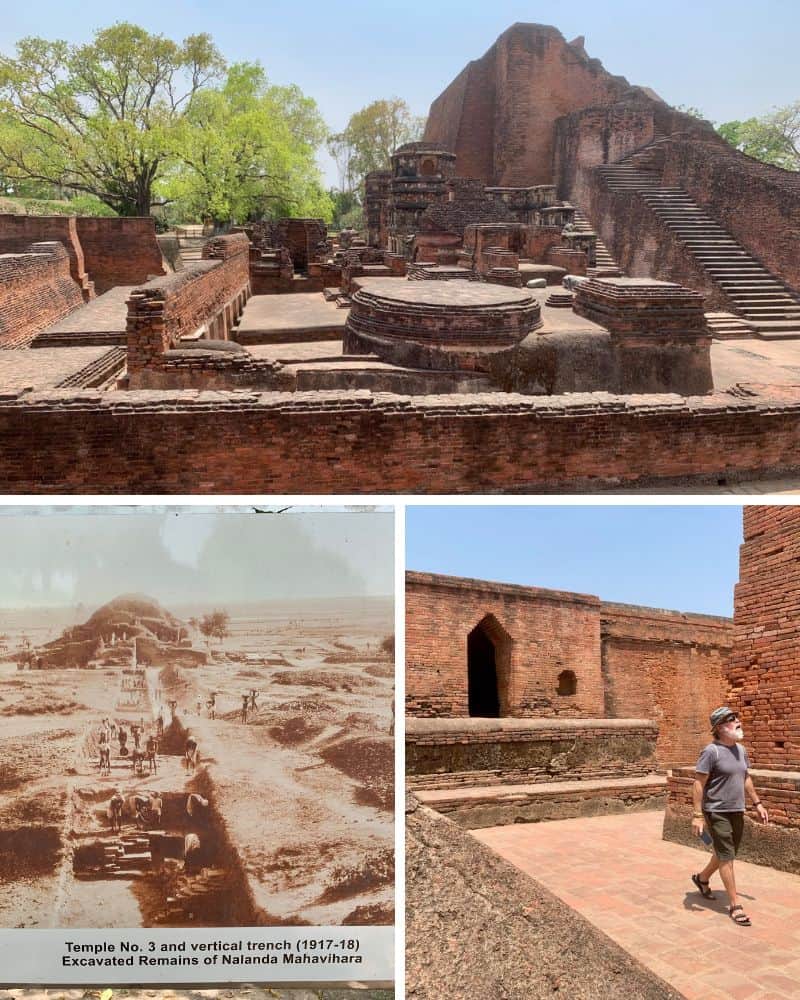
For anyone interested in Earth’s oldest university that changed human history, I highly recommend an article by the BBC (hat tip, Mom Diane). The article left my jaw on the floor.
The article points out that everything known about Buddhism today comes from Nalanda. Another legacy: an Indian mathematician assigned zero as a digit. There’s more. And you’d never guess if from the red-brick ruins. Much of the site is lost to time, probably still buried under what is now private land surrounding the old school site.
Ironically, we hired a guide who Theo says is quoted in that article. For 500 rupees ($6.10), his history talk was cheaper than the admission.
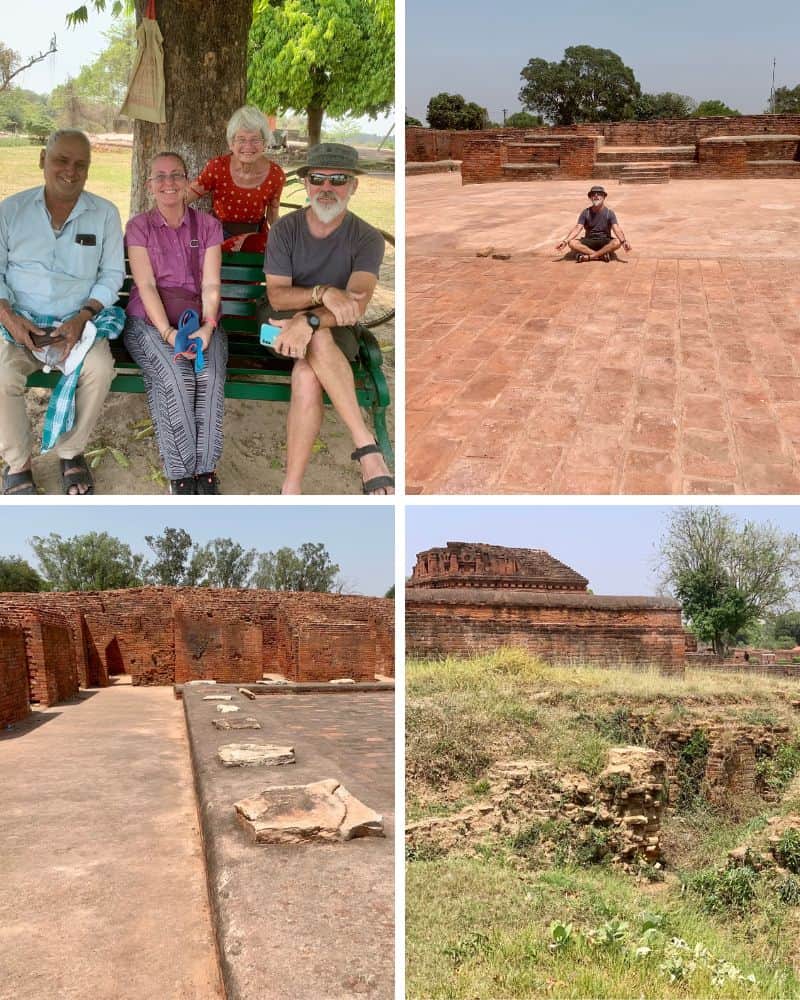
Entrance fee to the ruins for foreigners is 600 rupees ($7.30). For Indians, it’s only 40 rupees (50 cents). This price differential at Indian attractions always irks Theo, but it does not bother me. Especially when foreign companies hire Indians at rates westerners could not survive on.
There is a small museum across the street from the ruins site, which is worth a look while you’re there. It costs an extra five rupees (6.5 cents).
The official Buddhist Circuit tourist route is on the Bihar government’s website.
The Mountain Man’s story
There once was a woman who fell off a cliff and died from her injuries because she could not get to proper medical treatment in time. Her mourning husband decided to carve a path through a mountain to connect his poor village to a main road. Dashrath Manjhi — The Mountain Man — used only a chisel. It took him 22 years working night and day to move the mountain.
This is a true story. There have been Indian movies and shows based it. We stopped at the opening on the drive back to to Bodhgaya.
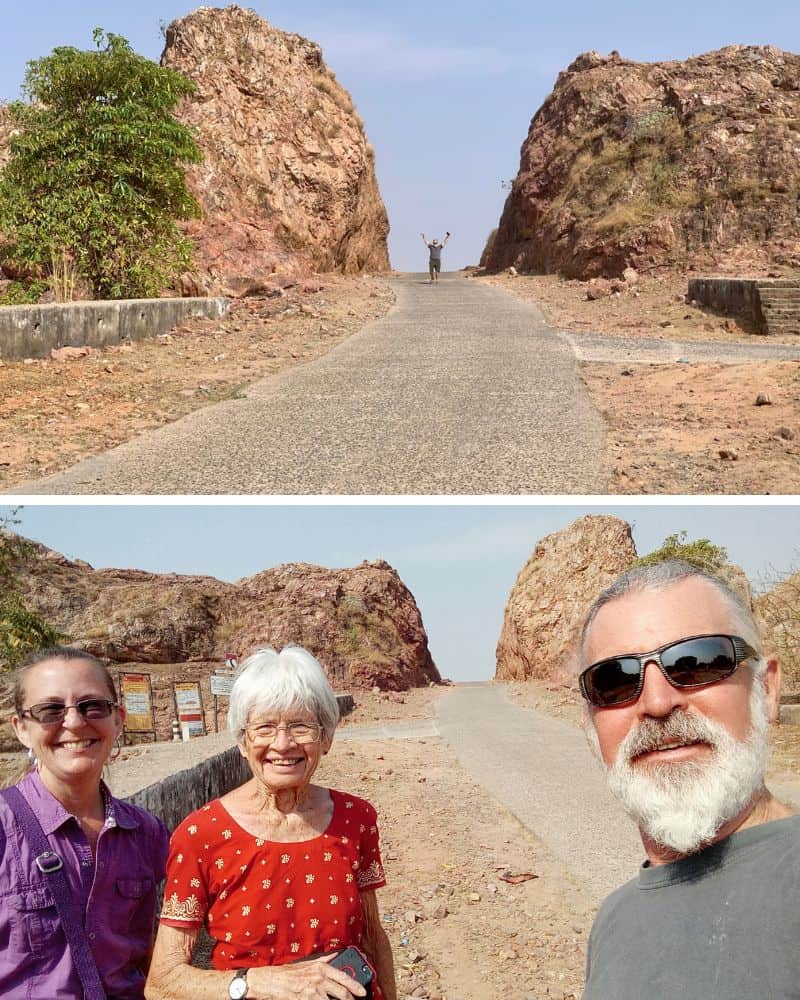
Theo was quite taken with the Mountain Man tale. It’s worth a quick stop – especially if you’re a romantic.
Bihar tourism around extreme poverty
Getting around in Bihar is an enlightening experience. I saw rural poverty unlike anywhere else I’ve witnessed so far. Bihar is one of the poorest states in India.
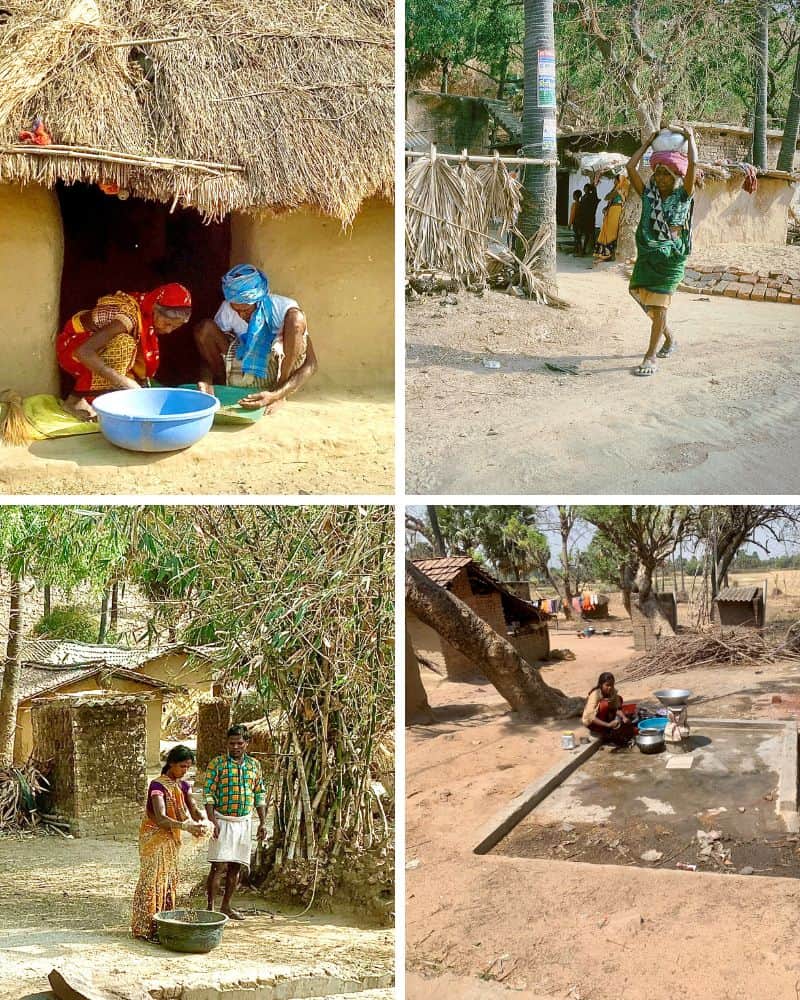
I give the state government credit for developing the Buddhist Circuit, and other efforts to bring in tourists to this region of India. If it hadn’t been so hot, I would have liked to spend more time outside. Our last few days was around 110; the day we left 113.
The Buddha teaches everything is impermanent – including my suffering from heat. However, I’ve got a way to go before I’m enlightened like a Buddha. I wasn’t quite able to quiet the mind enough to remain equanimous over immense physical discomfort from intense heat and swarms of mosquitoes.
My Bodhgaya slow travel advice for the unenlightened like me: carefully consider the season of your visit.

